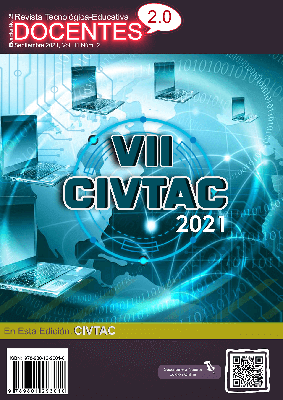Teaching and Learning of Industrial Robotics from Virtuality
 DOI:
https://doi.org/10.37843/rted.v11i2.245
DOI:
https://doi.org/10.37843/rted.v11i2.245
Main Article Content
Abstract
Together with the first manipulator robot, the UNIMATE from Devol and Engelberger, the concern of researchers and engineers was born to demonstrate the potential of similar robots in industrial applications. Consequently, many prestigious universities perceived how important it was to include subjects in curricula of careers such as Electrical Engineering, Electronics, Mechanics, or Mechatronics. The present investigation was under a mixed methodology. The analysis of results is supported by the response observed in a simulator through the combined use of a Toolbox for kinematic modeling of robots (based on executable scripts in an environment such as GNU Octave or similar). Of software for 3D simulation. The modeling of the use of the tools and the challenge to the student of programming virtual IRs in typical manufacturing, packaging, or palletizing scenarios, has been tested over four academic periods, obtaining positive feedback from those approved and graduates. The results achieved when simulating demonstrate the accuracy of the kinematic models obtained through mathematical formulations, which shows the usefulness of the tools described for distance learning based on practice.
Downloads
Metrics
Article Details

This work is licensed under a Creative Commons Attribution-NonCommercial-NoDerivatives 4.0 International License.
Those authors who have publications in our journal accept the following terms:
- When a work is accepted for publication, the author retains rights of reproduction, distribution of his/her article for exploitation in all countries of the world in the format provided by our magazine and any other magnetic medium, optical, and digital.
- Authors will retain their copyright and guarantee the journal the right first to publish their work, which will be simultaneously subject to the Creative Commons Acknowledgment License (Attribution-NonCommercial-NoDerivatives 4.0 International (CC BY-NC-ND 4.0)). That allows third parties to copy and redistribute the material in any medium or format, under the following conditions: Acknowledgment - You must properly acknowledge authorship, provide a link to the license, and indicate if any changes have been made. You may do so in any reasonable way, but not in a way that suggests you have the licensor's endorsement or receive it for your use. NonCommercial - You may not use the material for a commercial purpose. NoDerivatives - If you remix, transform, or build from the material, you cannot broadcast the modified material. There are no additional restrictions - You cannot apply legal terms or technological measures that legally restrict you from doing what the license allows.
- Authors may adopt other non-exclusive license agreements to distribute the published version of the work (e.g., deposit it in an institutional archive or publish it in a monographic volume) provided that the initial publication in this journal is indicated.
- Authors are allowed and recommended to disseminate their work through the Internet (e.g., in institutional telematic archives, repositories, libraries, or their website), producing exciting exchanges and increasing the published work's citations.
- Request of withdrawal an article has to be done in writing by the author to the Editor, becoming effective after a written response from the Editor. For this purpose, the author or authors will send correspondence via e-mail: [email protected].
- The author will not receive financial compensation for the publication of his work.
- All Docentes 2.0 Journal publications are under the Open Journal System (OJS) platform at: https://ojs.docentes20.com/.
References
Arango, C. (2006). Exploración de la metodología Top-Down Design en sistemas CAD para el desarrollo de un modelo de ingeniería. [Trabajo de Grado, Universidad EAFIT]. Recuperado de: https://repository.eafit.edu.co/handle/10784/276
Chennakaseva, A. (2014). Difference between Denavit-Hartenberg (D-H) classical and modified conventions for Forward Kinematics of robot with case study. International Conference on Advanced Materials and manufacturing (AMMT). JNTUH College of Engineering Hyderabad.
Craig, J. (2006). Robótica (3era ed.). Prentice Hall
Denavit, J. & Hartenberg, R. (1955). A kinematic notation for Lower-pair Mechanisms based on matrices. Transactions ASME Journal of Applied Mechanics, pp. 215–221. DOI: https://doi.org/10.1115/1.4011045
Eaton, J., Bateman, D., Hauberg, S. & Wehbring, R. (2021). GNU Octave (6.2.0) [Software]. https://www.gnu.org/software/octave/download
Fu, K., González, R. & Lee, C. (1988). Robótica: Control, Detección, Visión e Inteligencia. McGraw-Hill.
González, E. (2014). La Simulación como herramienta de análisis de procesos. https://www.milenio.com/opinion/varios-autores/universidad-politecnica-de-tulancingo/la-simulacion-como-herramienta-de-analisis-de-procesos
Koehler, M., Usevitch, N.S. & Okamura, A.M. (2020). Model-Based Design of a Soft 3-D Haptic Shape Display. IEEE Transactions on Robotics 36(3), pp.613-628 DOI: https://doi.org/10.1109/TRO.2020.2980114
Mujica, R. (2019). La tecnología en la educación. Revista Tecnológica-Educativa Docentes 2.0, 4(4), 4–7. https://ojs.docentes20.com/index.php/revista-docentes20/article/view/57
Ollero, A. (2007). ROBÓTICA. Manipuladores y robots móviles. Alfaomega - Marcombo.
Pardo, F. (1997). VHDL. Lenguaje para descripción y modelación de circuitos. Universidad de Valencia
Ríos, I., Ríos, S. & Martín, J. (2000). SIMULACIÓN. Métodos aplicaciones. Alfaomega.
Salazar, R. (2015). Desarrollo de las metodologías en la modalidad de educación a distancia. https://aprenderenlasociedaddigital.blogspot.com/
Sanz, W. (2016). Cinemática de Robots Industriales: Un enfoque pedagógico para el aprendizaje de la Robótica Industrial. (3era ed.). Editorial Académica Española.






